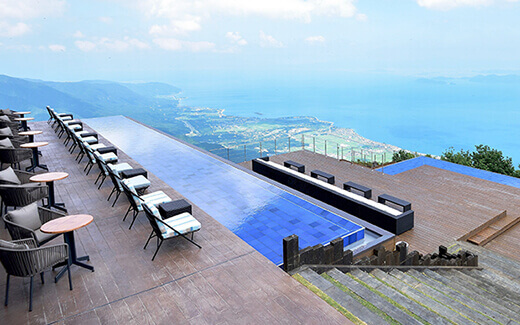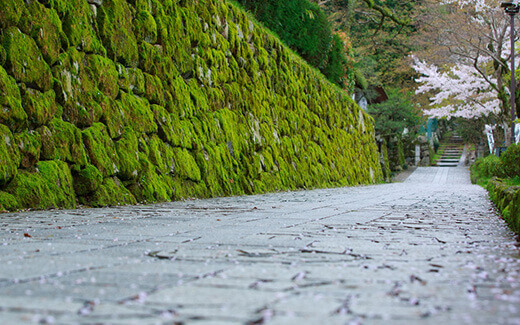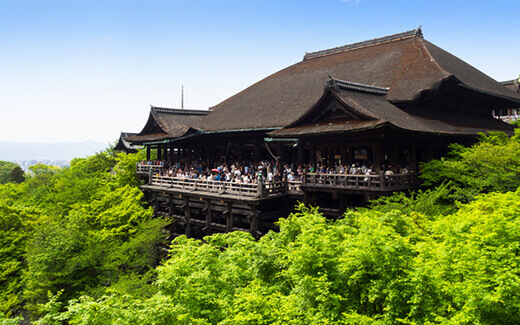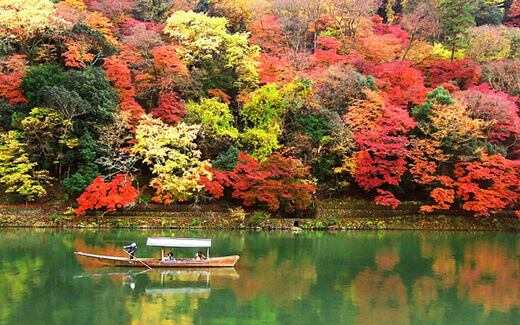
MENU

Enryakuji Temple is a World Heritage Site nestled in a beautiful natural environment. At an elevation of 800 m, it sits on a mountain overlooking Lake Biwa, Japan's largest lake. It is a mystical place that has over 1,200 years of history. The large grounds hold around 150 temple buildings, which many visitors from around the world come to pray at.
Website MAP
Biwako Valley is a nature resort overlooking Lake Biwa, the largest lake in Japan. 5 minutes from the mountain foot by ropeway, there are two unique terraces on the mountain top. From the Grand Terrace, you can see a magnificent view looking down on Lake Biwa from the sky. From the North Terrace, you can see the beautiful landscape of Lake Biwa and the mountains. Both are scenic views that attract visitors from all over the world.
Website MAP
Sakamoto is a town renowned for its stone walls, and it once flourished as a temple town of Hieizan Enryakuji Temple, which is registered as a UNESCO World Heritage Site. This town of history and culture overlooks Lake Biwa, the largest lake in Japan, right down below it. It's one of the most picturesque towns in Japan.
Website MAP
This temple is where Murasaki Shikibu started writing the Tale of Genji. Seasonal flowers bloom at the temple throughout the year, which makes it famous as a "temple of flowers." In autumn, the leaves of 2,000 maple trees vividly color the wollastonite rocks and temple halls. The autumn leaf illumination at night fantastically lights up the temple premises.
Website MAP
Kaizu Osaki has been chosen as one of the Top 100 Cherry Blossom Spots in Japan. Some 800 gorgeous Someiyoshino cherry trees—ranging from old ones that are over 80 years old to young ones that pass on their beauty to the next generations—line the bank of Lake Biwa for as long as four kilometers.
MAP
Omihachiman is the birthplace of Omi merchants. Many historic merchants' houses built in the Edo period still remain to date, and you can enjoy strolling around the retro town. Some of these houses are renovated and used as cafes and shops.
MAP
Kurokabe Square, a sightseeing spot featuring traditional buildings, is located in the old town of Nagahama City in the Kohoku region (the north of Lake Biwa) in Shiga Prefecture. Old buildings constructed during the Edo and Meiji periods have been renovated into glassware shops, galleries, glass workshops, restaurants, cafes, and so on.
MAP
Built around the theme of "people and the lake," it's an interactive museum where families can enjoy learning the history of Lake Biwa as well as the relationship between the people and the creatures living in the lake.
Website MAP
Kiyomizu-dera Temple is one of the foremost tourist spots in Kyoto. The name of the temple, Kiyomizu, comes from the holy spring in Mt. Otowa. The ever-flowing stream of the spring water forms the Otowa Waterfall.The scenery from the main hall surrounded by cherry blossoms or colored leaves is nothing short of magnificent. From the Kiyomizu Stage, you can enjoy a panoramic view of Kyoto City.
Website MAP
Fushimi Inari-jinja Shrine is popular for its rows of a thousand vermilion torii gates. The traditional shrine is one of the most popular tourist spots in Kyoto. The rows of vivid vermilion torii gates create a very mysterious atmosphere. The scenery is popular among foreign visitors and Japanese visitors alike.
Website MAP
If you would like to take a picture of cute jizo statues in Kyoto, Sanzen-in Temple in Kyoto Ohara is the best place. On the premises of Sanzen-in Temple, small jizo statues called Warabe Jizo stand here and there. Their content, smiling faces soothe the hearts of visitors.
Website MAP
Arashiyama is a tourist spot in Kyoto where you can enjoy natural beauty, as well as history, at its shrines and temples. In addition to historically valuable buildings that have been made famous tourist spots, the area is dotted with cafes and rest houses serving Japanese food.
MAP
Famous for the most beautiful autumn foliage, Eikando is one of the greatest landmarks in Kyoto. People call the temple "Eikando of maple leaves." In peak season, about 3,000 Japanese maple trees paint the chisenkaiyu-style garden, and add colors to the Tahoto Pagoda, Miei-do Hall, and other temple buildings.
Website MAP